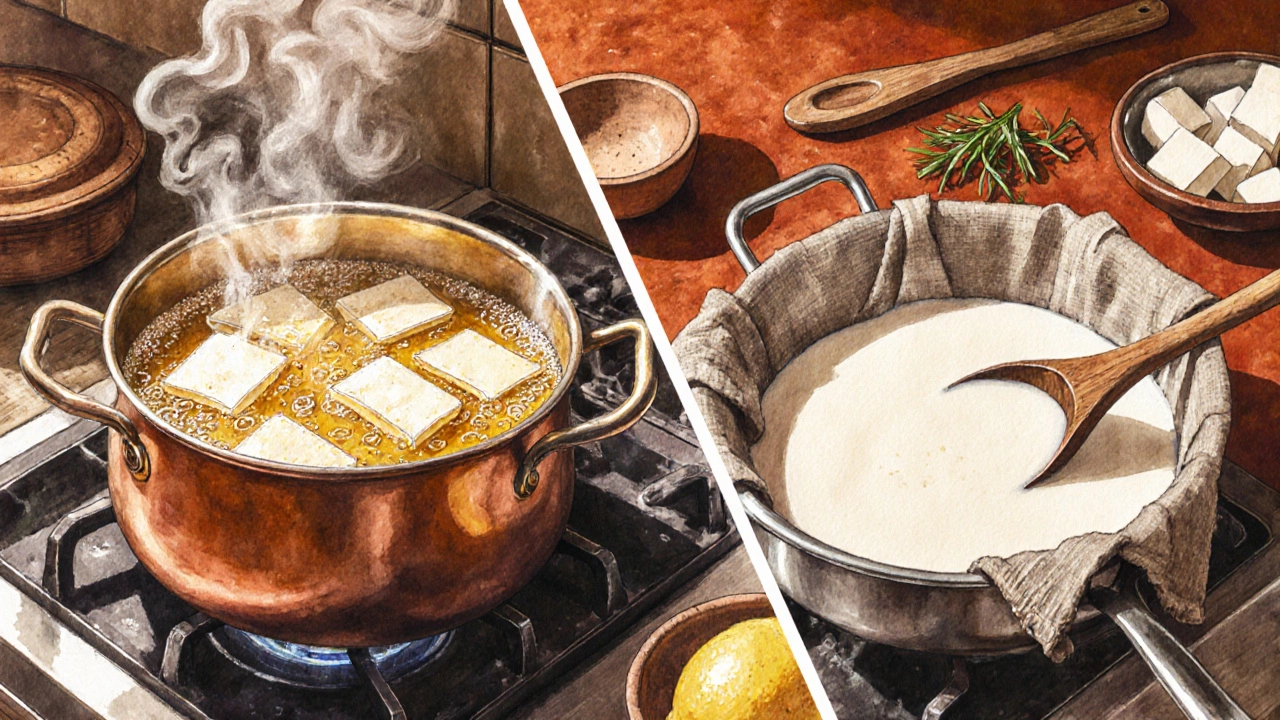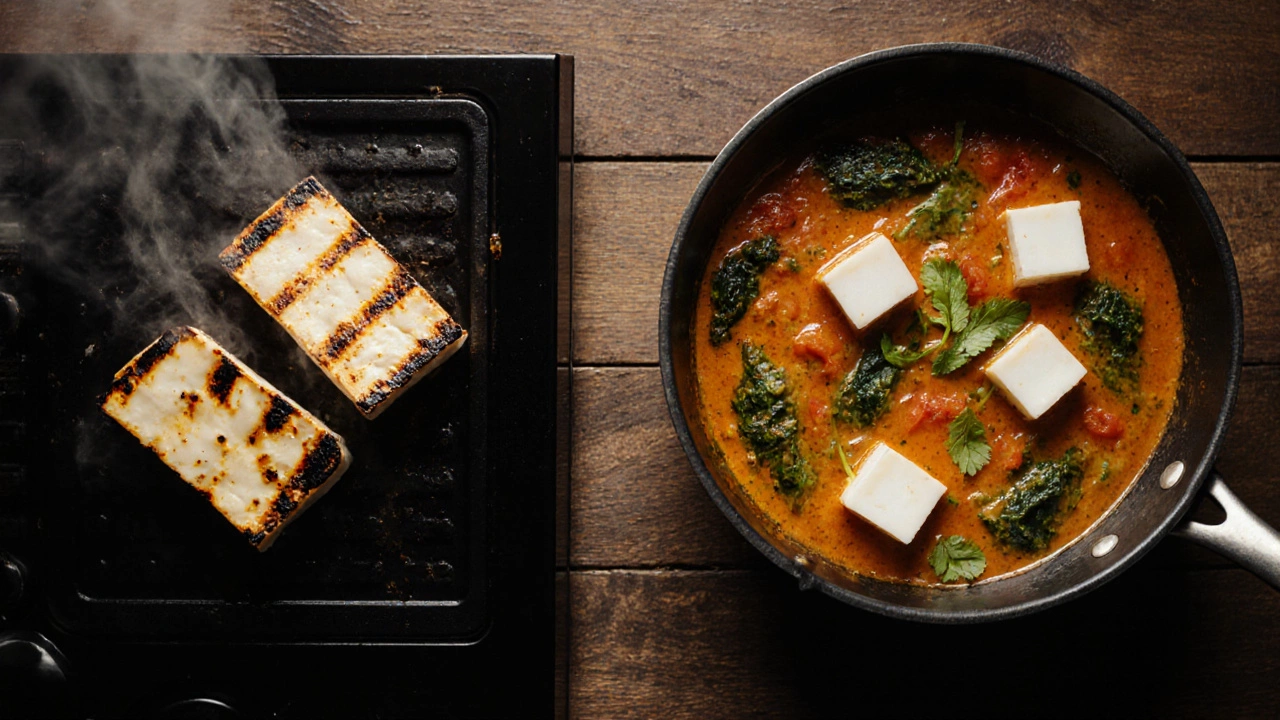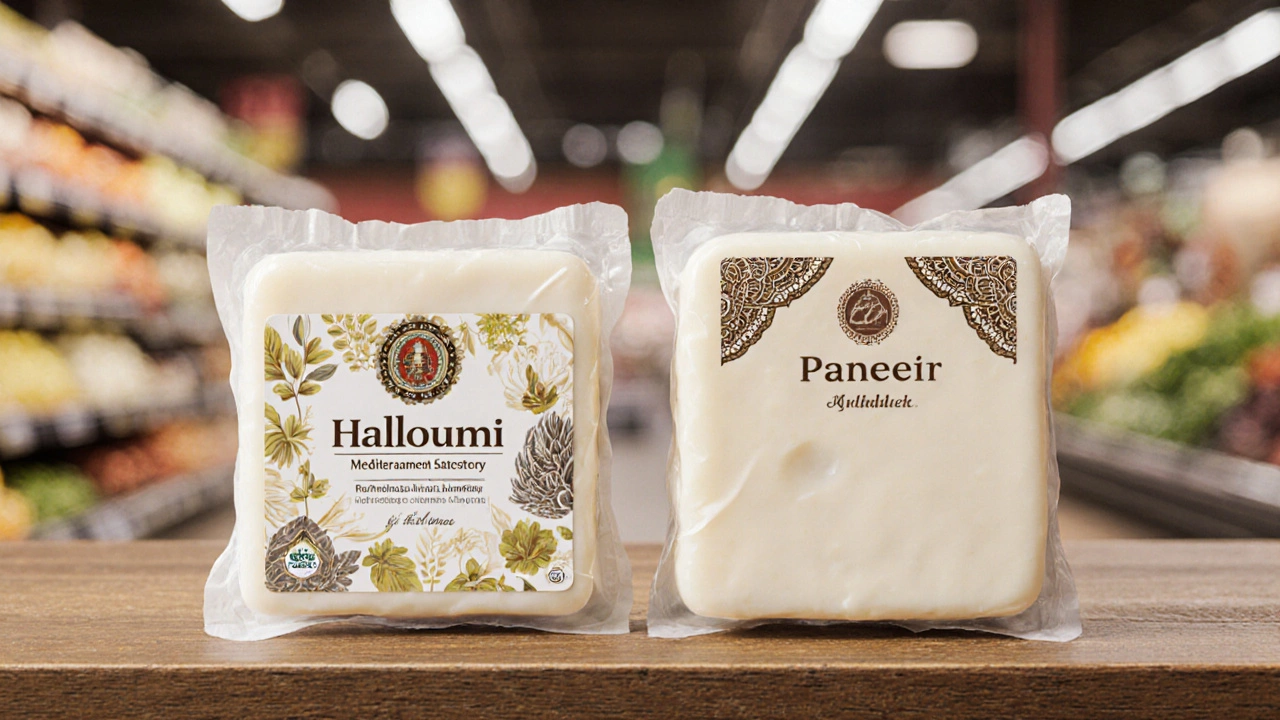Ever stared at a grocery shelf, saw halloumi and paneer side by side, and wondered if they’re just two names for the same thing? The answer isn’t a simple yes or no. While both are firm, white cheeses that love a good sear, their origins, production methods, and culinary personalities differ enough to give each its own fan club.
Key Takeaways
- Halloumi comes from Cyprus, paneer hails from India - geography shapes flavor.
- Halloumi is made with a mix of goat‑and‑sheep milk and is boiled twice; paneer uses only cow’s milk and is set with acid.
- Halloumi can be grilled without melting; paneer softens quickly and is best used in sauces or curries.
- Nutritionally, paneer is higher in protein, while halloumi carries more fat and calcium.
- You can swap them in a pinch, but expect texture and taste changes.
What Is Halloumi?
Halloumi is a semi‑hard cheese that originated on the island of Cyprus in the Eastern Mediterranean. Traditionally it blends goat’s milk with sheep’s milk, though many commercial versions use cow’s milk for cost reasons. After the curd is formed, the cheese is pressed, sliced, and then boiled in its own whey before being cooled in saltwater. The double‑cooking gives halloumi its signature squeaky bite and high melt‑point, which means you can grill or fry it without it turning to liquid.
What Is Paneer?
Paneer is a fresh, non‑aged cheese widely used across the Indian subcontinent. It’s made from cow’s (sometimes buffalo’s) milk that’s heated and then coagulated with an acid such as lemon juice, vinegar, or citric acid. Once the curds separate, they’re drained, pressed lightly, and cut into blocks. Because there’s no aging or cooking step, paneer stays soft, mildly milky, and does not melt when heated.
How the Two Cheeses Are Made: A Side‑by‑Side Look
| Aspect | Halloumi | Paneer |
|---|---|---|
| Primary milk source | Goat & sheep (often mixed with cow) | Cow (or buffalo) |
| Coagulation method | Rennet (enzymatic) + heat | Acid (lemon, vinegar, citric) |
| Cooking step | Boiled twice, then brined | No cooking, only draining |
| Texture after set | Firm, rubbery, squeaky | Soft, crumbly, milky |
| Typical salt content | High - stored in brine | Low - un‑salted |

Flavor, Texture, and Culinary Uses
When you bite into halloumi, you’ll hear a faint squeak - a sign of its high‑heat, protein‑tight structure. Its flavor leans salty, with buttery notes from the goat‑sheep blend. Because it holds up to grilling, it’s a star on Mediterranean salads, sandwich fillings, and even as a meat‑free burger patty.
Paneer, on the other hand, offers a milder, creamy profile that absorbs spices beautifully. It’s the backbone of dishes like palak paneer, paneer tikka, and shahi paneer. In curries, it softens but retains its shape, creating pockets of smooth protein.
In a pinch, you can swap halloumi for paneer in a grilled kebab, but expect a saltier bite and a chewier mouthfeel. Conversely, using paneer in a Mediterranean salad will lessen the salty punch and make the cheese melt a bit if the dressing is hot.
Nutritional Snapshot
Both cheeses provide calcium and protein, yet their macro profiles differ because of fat and salt levels.
- Halloumi (100g): ~300kcal, 22g protein, 24g fat, 2.5g carbs, 1.5g fiber, 1.2g salt.
- Paneer (100g): ~265kcal, 18g protein, 20g fat, 2g carbs, 0g fiber, 0.2g salt.
Paneer’s lower salt makes it a better choice for low‑sodium diets, while halloumi’s higher fat contributes to a richer mouthfeel. Both deliver about 200mg of calcium per serving, supporting bone health.
Can You Substitute One for the Other?
Here’s a quick decision tree:
- Do you need a cheese that will stay firm on a grill or pan? Halloumi is the safe bet.
- Is the dish a sauce‑heavy curry or gravy? Paneer will soak up flavors without turning rubbery.
- Are you watching sodium? Choose paneer.
- Do you want a smoky, salty finish? Halloumi shines.
If you must swap, rinse brined halloumi in water to tone down the salt, and press paneer longer to firm it up before grilling.

Common Misconceptions
- "Both are the same cheese, just different names." - False. Their milk sources, coagulation, and cooking steps are distinct.
- "Paneer melts like mozzarella." - Not true. Paneer softens but retains shape; it never stretches.
- "Halloumi is only for vegetarians." - While it’s vegetarian, many halloumi producers use animal rennet, which some strict vegetarians avoid.
DIY: Making Simple Halloumi at Home
If you’re curious, here’s a streamlined recipe that skips the traditional brining step but still gives you that grill‑ready squeak.
- Heat 4L of mixed goat‑sheep milk (or whole cow’s milk) to 85°C.
- Add rennet (1ml) and let sit 30minutes until curd forms.
- Cut curd into 1‑cm cubes, let rest 5minutes.
- Gently heat the curds to 95°C, stirring lightly.
- Drain whey, press curds in a cheesecloth for 20minutes.
- Slice the cheese, then simmer slices in fresh whey for 5minutes.
- Cool in a shallow saltwater bath (1% salt) for at least 2hours.
- Pat dry and grill - you’ll hear that signature squeak.
Even a rough home version lets you taste the textural difference that mass‑produced halloumi offers.
Frequently Asked Questions
Is halloumi suitable for vegans?
Traditional halloumi uses animal rennet, which vegans avoid. Some brands sell rennet‑free, plant‑based versions, so check the label.
Can I freeze paneer?
Yes. Freeze paneer in an airtight bag for up to 2months. Thaw in the fridge and press gently to remove excess moisture before cooking.
Why does halloumi squeak when I bite it?
The squeak comes from the protein structure tightening during the double‑boil process. When you bite, the fibers rub against each other, creating a subtle squeal.
Which cheese is better for a low‑fat diet?
Neither halloumi nor paneer is low‑fat, but paneer typically has slightly less fat per serving. Opt for low‑fat paneer varieties if available.
Can I replace paneer with halloumi in a curry?
You can, but the dish will be saltier and the cheese will stay firmer. Rinse halloumi first and add it at the end of cooking to keep the texture pleasant.
